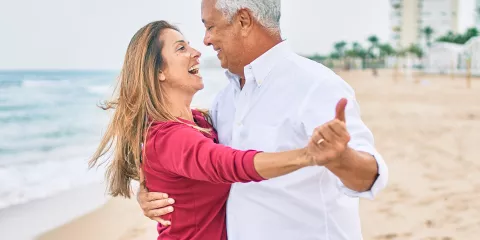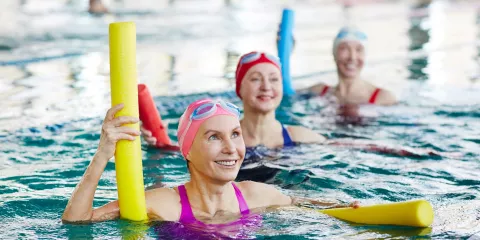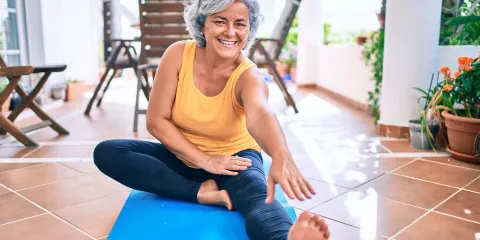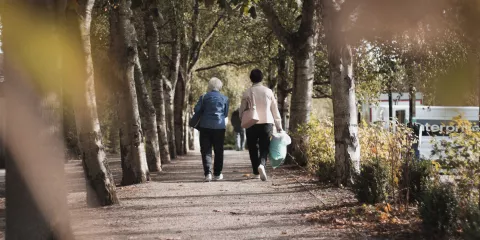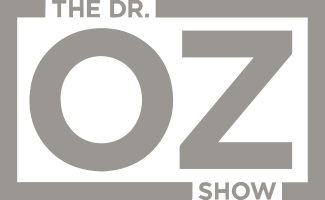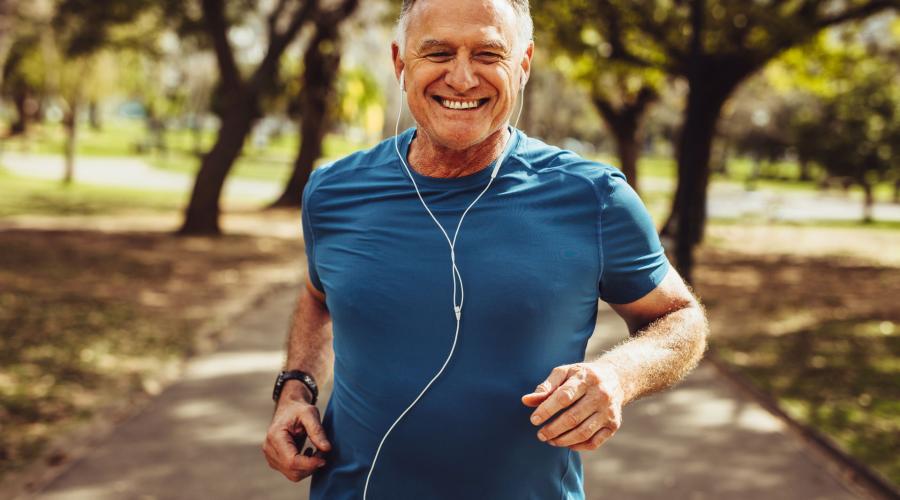
Whether you’re getting back into shape or looking to spice up your workout routine, you’ll need to choose between low impact exercise, high impact exercise, or both. Learn the pros and cons of each type of exercise and when you should choose one over the other. Be sure to talk to your doctor before starting any new exercise program.
Read More: Sneaky Ways to Improve Your Health
What Is Low Impact Exercise?
Low impact exercises allow you to keep one foot on the ground, which puts less stress on musculoskeletal tissues and joints. This type of exercise is a great choice if you are new to working out, have an injury, or just need a recovery day between higher impact workouts.
Low Impact Exercise Examples
Elliptical Cardio
An elliptical machine provides a good aerobic workout, which can strengthen your heart, lungs, and muscles. It’s also great for burning fat: according to Harvard Health Publications1 , you can burn up to 540-800 calories per hour working out on an elliptical trainer. Rowing and stair climber machines are other excellent low impact options that will build muscle strength while getting your heart rate up.
Water Aerobics
Water Aerobics can be a fun way to build muscle strength and cardio endurance. The buoyancy of water means there is less impact on your joints, making water aerobics a good option for if you have joint problems, experience chronic pain, are an older athlete, or are recovering from an injury. Most workouts involve a warm-up, cardio and strength-training exercises, and a cooldown, but the program can be customized to your needs and fitness goals.
Swimming
Swimming is a great all-body workout that can help you look good and feel good. Not only is lap swimming great for toning up and burning calories, it is known to lower blood pressure2 , control cholesterol, reduce stress levels, and help manage blood sugar levels in people with diabetes.3
Yoga
The 5,000-year-old practice of yoga combines strength and balance training with stretching and deep breathing for a total mind body workout. Studies show that yoga exercise lowers the risk of cardiovascular disease, obesity, and high blood pressure in middle-aged and older adults.4
Yoga tip for older athletes:
If mobility is a challenge, try a gentle chair yoga routine. A 2017 study found that chair yoga participants with osteoarthritis who took a 45-minute class twice a week experienced a significant reduction in pain and fatigue during the 8-week study.5
Biking
Biking is a fun, low impact way to burn calories without putting stress on your joints. Not only does it build muscle, the aerobic exercise is good for your heart, brain, and blood vessels.6
Walking
From improving circulation to improving mood7, the benefits of walking are nearly endless -- and all you need to get started is a pair of comfortable shoes. Walk around the office, stroll through the park while listening to your favorite music or catching up with a friend, or explore the great outdoors. If you need more of a challenge, consider our get-moving walking plan or training for a walk-friendly race.
What Is High Impact Exercise?
High impact workouts involve moving both feet off the ground at the same time. While high impact exercise can offer quicker results, they can also be harder on the body and have a higher risk of injury. The American Sports and Fitness Association recommends working with a personal trainer or coach to ensure that high impact exercises are done with proper form to prevent injury.8
Because this type of exercise has a high impact on the joints, it may not be right for those with joint problems, injuries, or cardiovascular disease. New guidelines from the American College of Sports Medicine recommend a heart check-up before embarking on a high-intensity exercise program, especially if you are not normally very active or have a pre-existing condition.9
High Impact Exercise Examples
Running
Not only does running burn a ton of calories, it can improve your confidence, relieve stress, and boost your mood.10
It can also help you live a longer life. According to a large-scale study published in the Journal of the American College of Cardiology, running reduces risk of death from all causes by 30 percent, and heart disease or stroke by an astonishing 45 percent.11
Best of all, you don’t need to run marathons to reap the fabulous benefits. The same study shows that even jogging for a few minutes a day or at slow speeds may “significantly” reduce a person’s risk of death from cardiovascular disease.
Skiing
Skiing involves a mixture of endurance and resistance training, and it is known to boost metabolism, fire up the muscles in your lower body, and improve cardiovascular health.12
Like other high impact exercises, skiing builds bone mass. That’s because bone is a living tissue that responds to the forces placed on it. When you exercise regularly, your body builds more bone and becomes denser.13
Tennis
A fantastic total-body workout, tennis burns an impressive 400 to 1,000 calories an hour. In addition to strengthening your lower body, upper body, and core, this form of high-intensity interval training also improves stamina, bone density, flexibility and balance (critical to preventing falls later in life).14
Cardio Exercises
In addition to high-intensity training programs like CrossFit, Insanity, and P90X, classic exercises like jumping jacks, knee-highs, and burpees are an effective form of cross training that you can do at home with minimal equipment. The folks at Verywell Fit have put together a handy guide of 19 cardio exercises you can do at home.
Whatever kind of exercise you choose, listen to your body and don’t overdo it. Drink plenty of liquids, especially when doing an activity that makes you sweat, and be sure to warm up with a light activity such as walking.
And remember, what it boils down to is this simple mantra: Move more and sit less15. Any amount of exercise is better than sitting on the couch -- and don’t be surprised if you begin to feel the pay-off from day one. New research16shows that exercise can help you start feeling better right away -- sharpening focus, reducing stress, improving sleep, and boosting your mood.
References
2https://www.ncbi.nlm.nih.gov/pmc/articles/PMC5260035/
4https://www.ncbi.nlm.nih.gov/pmc/articles/PMC4440276/
5https://www.ncbi.nlm.nih.gov/pmc/articles/PMC5357158/
6https://www.health.harvard.edu/staying-healthy/the-top-5-benefits-of-cycling
8https://www.americansportandfitness.com/blogs/fitness-blog/high-impact-vs-low-impact-exercises
10https://www.verywellfit.com/the-mental-benefits-of-jogging-2911666
11https://www.acc.org/about-acc/press-releases/2014/07/29/09/32/leisure-running-jacc-pr
12https://time.com/5118770/is-skiing-a-good-workout/
13https://orthoinfo.aaos.org/en/staying-healthy/exercise-and-bone-health/
14https://www.webmd.com/fitness-exercise/features/tennis-workout
16https://health.gov/sites/default/files/2019-11/PAG_MYW_Adult_FS.pdf
